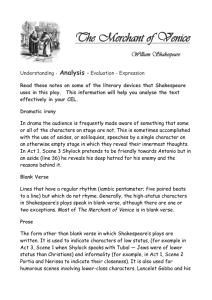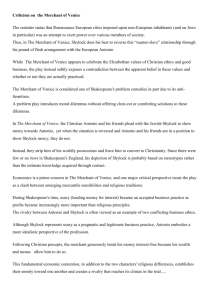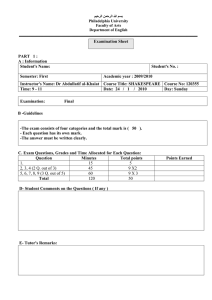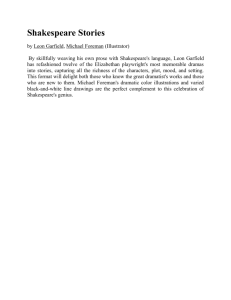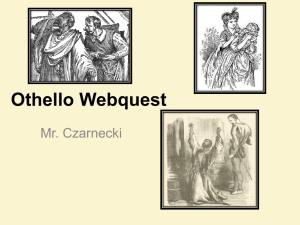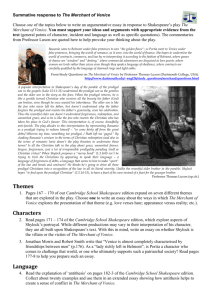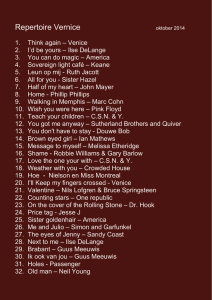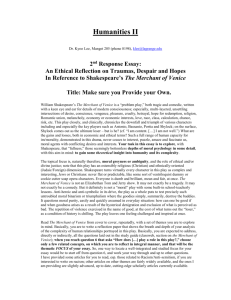Introduction to William Shakespeare
advertisement
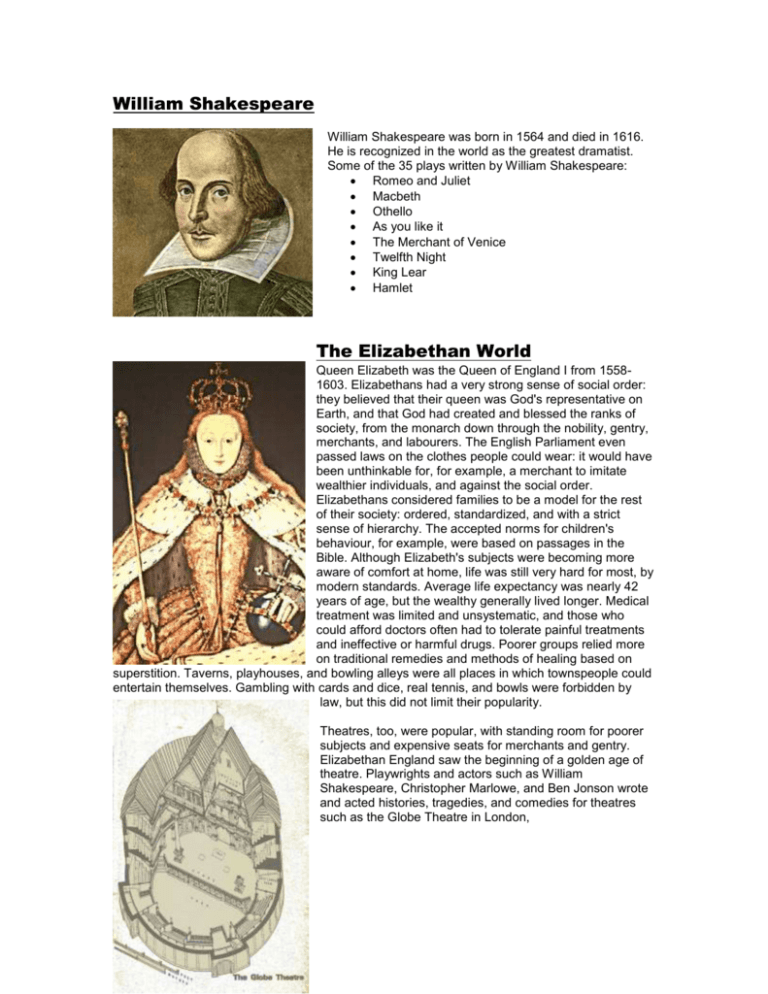
William Shakespeare William Shakespeare was born in 1564 and died in 1616. He is recognized in the world as the greatest dramatist. Some of the 35 plays written by William Shakespeare: Romeo and Juliet Macbeth Othello As you like it The Merchant of Venice Twelfth Night King Lear Hamlet The Elizabethan World Queen Elizabeth was the Queen of England I from 15581603. Elizabethans had a very strong sense of social order: they believed that their queen was God's representative on Earth, and that God had created and blessed the ranks of society, from the monarch down through the nobility, gentry, merchants, and labourers. The English Parliament even passed laws on the clothes people could wear: it would have been unthinkable for, for example, a merchant to imitate wealthier individuals, and against the social order. Elizabethans considered families to be a model for the rest of their society: ordered, standardized, and with a strict sense of hierarchy. The accepted norms for children's behaviour, for example, were based on passages in the Bible. Although Elizabeth's subjects were becoming more aware of comfort at home, life was still very hard for most, by modern standards. Average life expectancy was nearly 42 years of age, but the wealthy generally lived longer. Medical treatment was limited and unsystematic, and those who could afford doctors often had to tolerate painful treatments and ineffective or harmful drugs. Poorer groups relied more on traditional remedies and methods of healing based on superstition. Taverns, playhouses, and bowling alleys were all places in which townspeople could entertain themselves. Gambling with cards and dice, real tennis, and bowls were forbidden by law, but this did not limit their popularity. Theatres, too, were popular, with standing room for poorer subjects and expensive seats for merchants and gentry. Elizabethan England saw the beginning of a golden age of theatre. Playwrights and actors such as William Shakespeare, Christopher Marlowe, and Ben Jonson wrote and acted histories, tragedies, and comedies for theatres such as the Globe Theatre in London, Introduction to The Merchant of Venice The Setting of the play The play is set in Italy: in Venice and Belmont. Venice is a real place but Belmont is a place imagined by Shakespeare. The difference between Venice and Belmont is brought out clearly in the play. Venice: It was a city of great wealth and splendour. Its wealth came from trade and commerce. The merchants of Venice were the key figures in the city’s commercial success. Belmont: It is not near Venice. It is like a fairytale place, and has a beautiful lady, Portia, ruling over it. The Jews Jews had been expelled from England for nearly three hundred years. In Shakespeare’s time there was a great deal of fear, mistrust and ill-feeling against the Jews – there had even been anti-Jewish riots. Queen Elizabeth’s personal doctor, Roderigo Lopez, a Portugese Jew, had been publicly executed for an alleged attempt to poison her and this incident added to the antiJewish feeling in Elizabethan England. Usury: The ‘rights’ and ‘wrongs’ of lending money in return for interest, i.e. an additional sum of money to be repaid wit the original loan, were questions of crucial importance to the Elizabethans, and there were numerous articles and pamphlets written about usury. Today usury is such a common practise that we don’t question it. Each bank does it. In theory, most people agreed that usury was evil. It was natural to make a profit from trading but it was unnatural to make money from lending money to someone else. The Bible itself was the source of this Christian doctrine. Friendship: The bond of friendship between Bassanio and Antonio was seen as something natural and part of Renaissance life. It was considered the closest form of masculine friendship. This kind of friendship was a popular theme for plays. Woman Female roles in plays were played by boys dressed up as women. Basically, women had few privileges and almost no legal rights. In the play Portia is the head of her household and she has lots of money but the moment she gets married she must give everything over to her husband. Portia’s character reveals how resourceful woman had to become to have a say in society those days. The Shakespeare Play A play written by William Shakespeare usually consists out of five acts. Each act is devided into different scenes. Act I is usually the introduction of all the characters in the play. Act II is the development of the story. Act III is the development of a crisis. Act IV reaches the crises. Act V ends the play and ties all loose ends together. A Shakespearian play usually has themes. The themes are the main ideas of the play. Theme is sometimes defined as “the living idea” which emerges from the plot. Themes of The Merchant of Venice: The ‘bond’, Justice and Mercy Antonio enters into a bond with Shylock the Jew. A bond is like a contract/agreement you make with someone. You must keep it. The whole play centres on the bond and the repayment of this bond. Shylock expects justice. Many words are used in the play that has to do with justice, a bond, and mercy. Appearance versus reality A distinction is made in the play between how things appear and how they really are. You see the outside of the caskets but not the inside. Characters also appear to be what they are not. Chance or Destiny versus Choice Fortune is mentioned many times in the play. Things go well with some while others seems to struggle. Antonio takes a gamble when he sends his ships out to sea, but all merchants do that. Portia’s future lies in the hands of a man who chooses a casket. Shakespeare however suggests that although chance may play a role in the affairs of men, the correct choice of conduct, i.e. honour, good sense and true love will finally prevail. The ‘Ring’ theme The exchanging of rings to prove love echoes the bond theme. It emphasizes the bond scene between Shylock and Antonio. Glossary: Aside – Words spoken by an actor (sometimes in a loud whisper) which are heard by the audience, but are not supposed to be heard by the other characters on the stage. Soliloque – When a character speaks his deepest thoughts aloud to himself when he is alone, he speaks a soliloque or he soliloquizes. This dramatic technique enables the audience to know what is going on in the “privacy” of a character’s mind. Plot: The plot is what happens in the story – it is the order of events as arranged by the dramatist.
